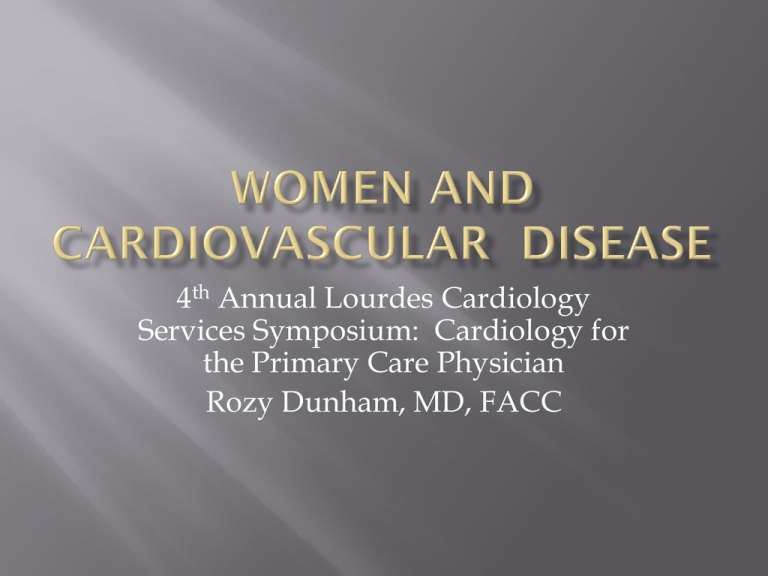
4th Annual Lourdes Cardiology
Services Symposium: Cardiology for
the Primary Care Physician
Rozy Dunham, MD, FACC
Heart disease is the leading cause of death for women
in the U.S.
1 in 3 women dies of heart disease, only 1 in 31 of
breast cancer
26% of women >45yo who have an initial MI die within
one year compared to 19% of men
Women are more likely to describe chest pain that is
sharp, burning, and more frequently have pain in the
neck, jaw, throat, abdomen, or back
In 2004, <50% of women recognized heart disease as
the #1 killer
In 2011, only 53% of women said they would call 911
first if they thought they were having a heart attack
Recognize the impact of cardiovascular disease
in women (CHD and Stroke)
Recognize the presentation of heart disease can
be different in women as compared to men
Identify risk factors unique to women for both
CHD and Stroke
Recognize treatments that are NOT beneficial
for CVD prevention in women
1999- First female specific guidelines for heart
disease prevention
2004- Evidence Based Guidelines for
Cardiovascular Disease Prevention in Women
2011-Effectiveness Based Guidelines for
Cardiovascular Disease Prevention in Women
2014- Guidelines for the Prevention of Stroke in
Women; a statement from the AHA and ASA
Written in the wake of the Women’s Health
Initiative and HERS trial
Need for strategies to prevent heart disease in
women
Assess and stratify women into high, intermediate,
lower, or optimal risk categories
Lifestyle approaches to prevent CVD for all
women and a top priority (smoking cessation,
regular exercise, weight management, and heart
healthy diet)
Other CVD risk-reducing interventions (BP
management, lipid management, DM
management)
Higher priority for therapy for highest risk
patients
Avoid Class III interventions (not beneficial, may
be harmful)
Based on the Framingham Risk Score
No such thing as NO risk
High Risk (>20%):
Established CHD
Cerebrovascular disease
Peripheral arterial disease
AAA
DM
CKD
Intermediate Risk (10-20%):
Subclinical CHD (coronary Ca)
Metabolic syndrome
Multiple risk factors (smoking, HTN, HPL, obesity,
poor diet, physical inactivity)
Autoimmune collagen vascular disease (SLE, RA)
Family history of early onset CVD
History of preeclampsia, gestational DM, or pregnancy
induced HTN)
Lower Risk (<10%):
Multiple risk factors, metabolic syndrome, or 1 or no
risk factors
Optimal Risk (<10%):
Optimal levels of risk factors and heart healthy lifestyle
(ideal lipids, HTN, blood glucose, BMI, non-smoker,
physically activity, healthy diet)
Recommended for ALL women
Smoking cessation
Physical activity (30 minutes of moderate-intensity
exercise most days of the week)
Cardiac rehab
Heart healthy diet
Weight maintenance/reduction (BMI 18.5-24.9
kg/m2; waist circumference <35 in.)
Psychosocial Factors
Omega 3 fatty-acid supplementation in high risk
patients
Optimal BP <120/80
Lipid Management
DM management
ASA for high or intermediate risk patients, or
clopidogrel if intolerant of ASA
Beta Blockers in women with h/o MI
ACE in high risk women
ARB in high risk women intolerant of ACE
Warfarin/ASA for a.fib a stroke prevention
Hormone Therapy (combined
estrogen/progestin or unopposed estrogen)
should NOT be used for CVD prevention
Antioxidant supplements
ASA for lower risk patients
Reversing a trend over the last 40 years, CHD
death rates in US women 35-54yo appear to be
increasing, likely due to the obesity epidemic
Death rates higher in black vs. white women
Leading cause of death in women in every
major developed country
Flow diagram for CVD preventive care in women.
Mosca L et al. Circulation. 2011;123:1243-1262
Copyright © American Heart Association, Inc. All rights reserved.
Did not endorse routine use of high-sensitivity
CRP for screening purposes
Did discuss unique opportunities to assess a
women’s risk, like at time of pregnancy
Preeclampsia may be an early indicator of CVD
risk
Hormone therapy, including selective estrogenreceptor modulators, should not be used for primary
or secondary prevention of CVD
Antioxidant supplements (vitamin E, C, and beta
carotene) should not be used for primary or secondary
prevention of CVD
Folic Acid with or without B6 and B12
supplementation should not be used for primary or
secondary prevention of CVD
Routine use of ASA for prevention of MI in healthy
women <65 yo (ASA can be useful in women >65yo if
BP controlled and benefit for ischemic stroke
prevention and MI prevention is likely to outweigh
risk of GIB and hemmorhagic stroke)
February 2014
Stroke accounts for a higher proportion of CVD
events than CHD in women (opposite for men)
Lifetime risk of stroke higher in women, mostly
because women live longer
53.5% of new or recurrent strokes occur among
women
In 2010, 60% of deaths related to stroke were in
women
Majority are ischemic strokes vs. hemorrhagic
Risk factors unique to women
Risk Factor
Pregnancy
Preeclampsia
Gestational
diabetes
Oral contraceptive
use
Postmenopausal
hormone use
Changes in
hormonal status
Migraine with
aura
Atrial fibrillation
Diabetes mellitus
Hypertension
Sex-Specific Risk
Factors
Risk Factors With
Similar Prevalence
Risk Factors That
in Men and
Are Stronger or
Women but
More Prevalent in
Unknown
Women
Difference in
Impact
X
X
X
X
X
X
X
X
X
X
Physical inactivity
X
Age
Prior
cardiovascular
disease
Obesity
Diet
Smoking
Metabolic
syndrome
Depression
X
X
Psychosocial stress
X
X
X
X
X
X
Preeclampsia/eclampsia and pregnancyinduced HTN
Continue to be at high risk for stroke even after
birth
ACOG recommends treatment of severe HTN
in pregnancy (systolic BP >160 mmHg or
diastolic BP>110 mmHg)
Labetolol is first-line therapy
AVOID atenolol, ACE, and ARB
History of preeclampsia, eclampsia, pregnancy
induced HTN, gestational DM all are
associated with a higher risk of CVD and
stroke beyond the childbearing years
In one 2012 study, 18.2 % of women with a
history of preeclampsia vs. 1.7 % of women
with uncomplicated pregnancies had a CVD
event in 10 years
Women with chronic primary or secondary HTN or
previous pregnancy related HTN should take a low dose
ASA from the 12th week of gestation until delivery
Calcium supplementation (>1g/day) should be considered
for women with low dietary intake of calcium to prevent
preeclampsia
Severe HTN in pregnancy should be treated
Consider treatment of moderate HTN
Atenolol, ACE, ARB contraindicated
After birth, women with chronic HTN should continue to be
treated and monitored for post-partum preeclampsia
Because of increased risk of future HTN and stroke 1-30
years after delivery in women with a history of
preeclampsia, it is reasonable to evaluate and treat for HTN,
obesity, smoking, and dyslipidemia
Thrombus formation in >1 of the venous
sinuses
0.5%-1% of all strokes
>70% of cases in women
2 major risk factors include oral contraceptive
use and pregnancy
Screen and test for prothrombotic conditions
Warfarin for 3-6 months in provoked CVT
6-12 months in unprovoked CVT
Indefinite anticoagulation for recurrent CVT
In CVT with pregnancy, LMWH throughout
pregnancy and >6 weeks post-partum
Future pregnancy not contraindicated
Women with a history of CVT can be treated
prophylactically with LMWH during future
pregnancies
2.75 fold increase in ischemic stroke with any
OC use
Progestogen only OCs revealed no significant
increased risk
Overall slightly increased risk of hemorrhagic
stroke
Increased risk with obesity, HPL, smoking,
HTN, migraine headaches and OC use
OCs may be harmful in women with additional
risk factors (smoking, prior thromboembolic
events)
Among OC users, aggressive therapy of stroke
risk factors reasonable
Routine screening for prothrombotic mutations
before initiation of OC is NOT useful
Measurement of BP before initiation of OC is
recommended
Data seems to suggest increased risk of stroke
with earlier onset of menopause (before age 42)
although evidence is inconsistent
Studies of HT for primary and secondary
prevention of stroke have been negative
HERS, WEST, and WHI
HT does not reduce stroke risk and may
increase risk
HT (conjugated equine estrogen with or
without medroxyprogesterone) should not be
used for primary or secondary prevention of
stroke in post-menopausal women
SERMs, such as raloxifene, tamoxifen, or
tibolone, should not be used for prevention of
stroke
Women are 4 times more likely than men to
have migraines
Migraine with aura is associated with double
the risk for ischemic stroke
This association is higher in women than men
Risk increases even more with smoking and
OC use
Treatment to reduce migraine frequency is
reasonable as there is an association between
higher migraine frequency and stroke risk
Evidence is lacking that treatment reduced risk
of first stroke
Strongly recommend smoking cessation in
women with migraine and aura
Obesity, metabolic syndrome, and lifestyle
factors
Prevalence of obesity higher in women than in
men
Recommendation are same for men and
women: regular physical activity, moderate
alcohol consumption, abstention from
smoking, and healthy diet
AF increases with age and women have greater
life expectancy
60% of AF patients >75yo are women
Risk stratification : CHADS2 and CHA2DS2VASc score
Female sex is an independent predictor of
stroke in AF
Risk stratify patients
Considering the increased prevalence of AF
with age and the higher risk of stroke in elderly
women with AF, active screening (age >75) in
primary care settings is appropriate
Oral AC in women <65yo with AF alone and
no other risk factors is not recommended
(CHADS2=0, CHA2DS2-VASc=1). Antiplatelet
therapy is a reasonable option
New oral anticoagulants are a useful
alternative to warfarin in appropriate patients
Management of carotid disease (symptomatic
or asymptomatic) same as for men
ASA therapy in women with DM, high-risk
patients, and women >65yo if benefit is likely
to outweigh the risk
Many gaps remain in our knowledge regarding
sex differences in CVD and prevention
More awareness among women
Sex specific risk scores necessary
More women need to be represented in clinical
trials of CVD
Until then, management remains essentially the
same as for men (ASA)








